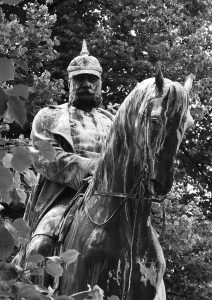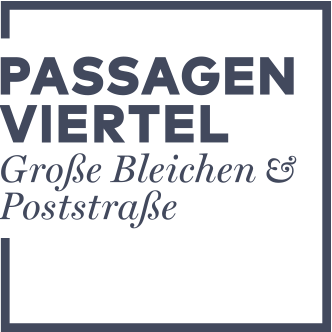1881
1881
Kaisergalerie – majestic not only in name
The Kaisergalerie sits on the site of the former Jenisch-Palais, where the Hamburg government hosted a dinner for emperor Wilhelm I in 1881. His imperial highness was accompanied by numerous princes and members of the nobility. In 1907 this prestigious house was replaced by the no less splendid complex occupying the site to this day. The historic occasion of the imperial visit lives on in the word »Kaiser« (»emperor«) in the »Kaisergalerie« name.Set back from the street, the patrician Jenisch-Palais never vied for attention. The main building, with its back to the Bleichenfleet canal, overlooked a spacious courtyard. Two smaller buildings shielded it against direct view from the street, from which it was accessible through a portal with three driveways. Built in renaissance style, the three-storey main building had an aristocratic air about it. A large foyer gave way to an impressive flight of marble stairs leading up to the magnificent rooms on the main floor, including the large ballroom with its beautifully painted ceiling and the paintings gallery.
 The Jenisch-Palais was built in 1845 for Senator Martin Johann Jenisch (* 12 April 1793 in Hamburg; † 7 March 1857 in Vevey, Switzerland) following the destruction of his house in an 1842 fire. The design thought up by architect Auguste de Meuron was very much appreciated by his client and won the architect a string of assignments from members of the local nobility. The Jenisch-Palais saw numerous celebrations, feasts and parties during Senator Jenisch’s lifetime. On the occasion of the laying of the foundation stone for the Kiel Canal in 1881, Hamburg had the honour of welcoming Wilhelm I as the German emperor for the first time.
The Jenisch-Palais was built in 1845 for Senator Martin Johann Jenisch (* 12 April 1793 in Hamburg; † 7 March 1857 in Vevey, Switzerland) following the destruction of his house in an 1842 fire. The design thought up by architect Auguste de Meuron was very much appreciated by his client and won the architect a string of assignments from members of the local nobility. The Jenisch-Palais saw numerous celebrations, feasts and parties during Senator Jenisch’s lifetime. On the occasion of the laying of the foundation stone for the Kiel Canal in 1881, Hamburg had the honour of welcoming Wilhelm I as the German emperor for the first time.
Since the local government did not have a venue suitable for entertaining an imperial guest at its disposal in those days, the Senate decided to hold the dinner in honour of his majesty in the Jenisch-Palais. The entire building was decked out in flowers and lights. Its forecourt resembled a palm grove, the portal was crowned by a yellow silk canopy and the inner courtyard was exquisitely decorated throughout. Musical accompaniment for the festive dinner was provided by the regimental band playing in a tent put up on barges anchored on the Bleichenfleet canal at the back of the building.
The ensuing years saw the Jenisch-Palais, one of the few prestigious residences remaining in central Hamburg, fall into disuse. In 1907 many works of art including the paintings set into the ceilings were auctioned off, with some pieces being acquired by the then Museum of Hamburg History. The building itself was torn down to make way for a prestigious office and retail complex named Kaisergalerie.
